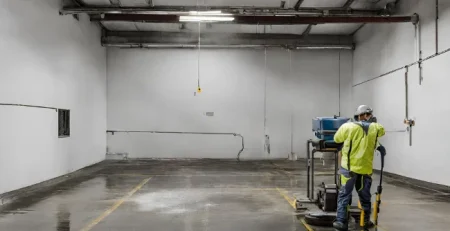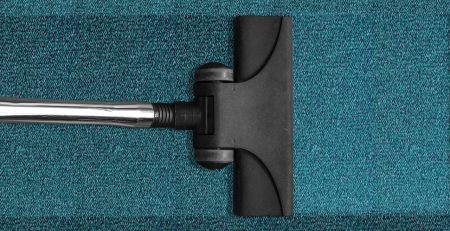Keeping a church clean goes beyond appearances, it’s about creating a welcoming, safe, and sacred space for worship, reflection, and community gatherings. Whether you’re a church administrator, janitorial staff member, or a volunteer stepping up to help, having a clear and organized cleaning plan ensures that no detail is overlooked. From pews and pulpits to restrooms and fellowship halls, every area plays a role in the spiritual and physical well-being of the congregation.
In this blog, we’ll walk you through a comprehensive Church Cleaning Checklist to help maintain the cleanliness, order, and reverence your house of worship deserves.
Daily Church Cleaning Checklist
A consistent daily cleaning routine helps maintain the church’s appearance, ensures a hygienic environment, and reduces the workload for deeper weekly or monthly cleanings. The following daily church cleaning checklist is designed to cover high-traffic areas and essential tasks to keep your church fresh and welcoming every day.
Sanctuary
- Wipe down pews, chairs, and kneelers – Remove dust, fingerprints, and any debris left from previous services.
- Vacuum or sweep floors and carpets – Focus on main aisles, altar steps, and under seating.
- Dust podiums, altars, and musical equipment – Use microfiber cloths to prevent buildup without damaging surfaces.
- Empty trash bins – Replace liners and sanitize bin surfaces if needed.
Entrances and Lobbies
- Sweep or vacuum entryways – Pay attention to debris brought in by foot traffic.
- Clean glass doors and windows – Remove fingerprints and smudges.
- Disinfect door handles and railings – Especially important during cold and flu season.
Restrooms
- Sanitize toilets, sinks, and countertops – Use disinfectant to eliminate germs and odors.
- Restock supplies – Refill toilet paper, soap, and paper towels.
- Empty trash and sanitary bins – Dispose of waste properly and replace liners.
- Mop floors – Use disinfectant cleaner and allow to dry thoroughly.
Offices and Meeting Rooms
- Tidy desks and surfaces – Remove clutter and dust.
- Wipe down electronics – Gently clean phones, keyboards, and light switches.
- Empty wastebaskets – Dispose of trash and recyclables.
General Notes
- Use appropriate cleaners for wood, glass, and electronics to avoid damage.
- Report any maintenance issues (e.g., leaks, broken fixtures) immediately to avoid larger problems.
- Ensure all areas are ventilated during and after cleaning for safety and freshness.
Weekly Church Cleaning Checklist
While daily cleaning takes care of immediate needs, weekly deep cleaning helps address areas that accumulate dirt and dust over time. These tasks focus on thorough maintenance to preserve the church’s appearance, ensure cleanliness for worship services, and promote a healthy environment for your congregation.
Sanctuary
- Vacuum and mop all flooring thoroughly – Move chairs or pew cushions if possible to clean underneath.
- Polish wood surfaces – Apply appropriate polish to pews, altars, podiums, and other wooden fixtures to maintain their finish.
- Dust high and hard-to-reach areas – Including ceiling fans, light fixtures, vents, and decorative molding.
- Clean communion areas and sacred items – Use gentle, appropriate products to clean chalices, trays, and communion tables.
- Inspect and clean upholstery – Check pew cushions or chairs for stains, dust, or damage.
Restrooms
- Deep clean all surfaces – Scrub toilets, sinks, floors, and walls with disinfectant.
- Sanitize under and behind fixtures – Don’t overlook corners and less visible areas where germs and dirt accumulate.
- Check for plumbing or maintenance issues – Report or repair leaks, running toilets, or broken dispensers.
Entrances, Hallways & Lobbies
- Clean and polish entry doors – Including door frames and handles.
- Wipe down signage, bulletin boards, and decorative items – Remove dust, smudges, or fingerprints.
- Spot-clean walls and baseboards – Look for scuffs, handprints, or marks that accumulate over time.
Classrooms and Meeting Spaces
- Disinfect tables, chairs, and commonly used items – Especially if used by children or multiple groups.
- Organize supplies and storage areas – Return items to their proper place and tidy shelves or closets.
- Vacuum carpets and clean rugs – Pay special attention to corners and under furniture.
Kitchen and Fellowship Hall (if applicable)
- Clean appliances and surfaces – Wipe down refrigerators, microwaves, countertops, and sinks.
- Disinfect tables and chairs – Especially after events or gatherings.
- Empty and sanitize trash bins – Clean inside and outside of bins to prevent odor and bacteria buildup.
Pro Tip: Assign specific areas to team members or volunteers to streamline the cleaning process and ensure accountability. Rotating tasks weekly can help prevent burnout and promote consistency.
Monthly Church Cleaning Checklist
A monthly cleaning routine is your opportunity to tackle the deeper, more detailed tasks that don’t require daily or weekly attention but are essential for preserving the church’s beauty, functionality, and longevity. This checklist focuses on long-term upkeep, addressing areas often overlooked during regular cleanings.
Sanctuary
- Clean and condition woodwork – Use appropriate wood conditioners on pews, altars, and railings to preserve their finish and prevent cracking.
- Wash windows (inside and out) – Remove built-up dirt and streaks to let in natural light and enhance the sacred atmosphere.
- Dust and clean light fixtures and ceiling fans – Eliminate cobwebs and dust from chandeliers, pendant lights, and vents.
- Inspect and clean stained glass – Gently dust and spot-clean with a non-abrasive cleaner as needed.
- Check for needed repairs – Look for loose screws, damaged flooring, or wear on kneelers and hymnals.
Restrooms
- Deep clean grout and tile – Use grout cleaner or steam to restore brightness and eliminate buildup.
- Sanitize walls and partitions – Wipe down all surfaces, including behind toilets and under sinks.
- Inspect plumbing – Check for leaks, water damage, or signs of mold.
Offices, Classrooms & Meeting Rooms
- Clean behind and under furniture – Move desks, chairs, and shelves to vacuum or mop hard-to-reach areas.
- Organize storage spaces – Sort through supplies, discard outdated materials, and label bins or cabinets.
- Disinfect electronics and shared equipment – Include telephones, keyboards, printers, and remote controls.
Kitchen & Fellowship Areas
- Clean inside appliances – Wipe down the interiors of refrigerators, ovens, microwaves, and freezers.
- Check for expired food or supplies – Safely discard and replace outdated items.
- Wash table linens, curtains, or chair covers – Launder and press as needed.
Exterior Areas (if applicable)
- Sweep entrances and walkways – Remove leaves, trash, or other debris.
- Clean outdoor signage – Ensure readability and remove dirt or buildup.
- Inspect gutters, downspouts, and roofing – Report any visible issues to maintenance or leadership.
Pro Tip: Use the monthly cleaning session as a time to document maintenance needs, inventory supplies, and plan for seasonal cleaning or special event preparation.
Quarterly Church Cleaning Checklist
Every few months, it’s important to go beyond surface-level cleaning and tackle tasks that protect the church’s structure, systems, and appearance over time. Quarterly church cleaning ensures that your building remains a safe, comfortable, and spiritually uplifting space, especially as seasons change and special services approach.
Sanctuary
- Shampoo carpets and clean rugs – Remove deep-seated dirt, stains, and allergens from carpets in high-traffic areas.
- Polish metal fixtures and hardware – Clean and shine offering plates, candleholders, railings, and door handles.
- Deep clean altar linens and vestments – Launder according to proper care instructions or arrange for professional cleaning.
- Inspect and repair hymnals or Bibles – Replace worn covers, torn pages, or missing items.
Windows, Walls, and Ceilings
- Wash interior walls – Remove smudges, fingerprints, or any mold/mildew buildup, especially near baseboards.
- Inspect ceiling tiles and light panels – Check for stains, dust, or signs of water damage.
- Clean and dust behind wall hangings and decorations – Prevent dust buildup and preserve artwork or signage.
Furniture and Fixtures
- Condition all wooden furniture – Apply wood treatment or polish to pews, tables, podiums, and cabinetry.
- Tighten screws and fix loose furniture – Ensure pews, chairs, and tables are safe and stable.
- Deep clean and deodorize upholstered seating – Use fabric-safe cleaners or schedule professional service if needed.
Storage and Supply Areas
- Inventory cleaning and maintenance supplies – Reorder items, dispose of expired products, and organize storage rooms.
- Declutter lost-and-found and donation bins – Return or donate unclaimed items.
Exterior & Grounds (if applicable)
- Inspect and clean outdoor signage, lighting, and entranceways – Ensure everything is visible, functional, and welcoming.
- Clean windows and siding – Consider pressure washing or gentle exterior cleaning depending on the building material.
- Inspect landscaping and parking areas – Check for seasonal maintenance needs, such as fallen branches, cracked pavement, or overgrown shrubs.
Pro Tip: Coordinate quarterly cleanings with the church calendar, right before Easter, summer programs, fall kickoff, or Christmas, to prepare your space for increased foot traffic and special events.
Equipment and Supplies Used for Church Cleaning Services
Effective church cleaning requires more than just time and effort; it depends on using the right tools and supplies to get the job done thoroughly and efficiently. Whether you’re managing an in-house cleaning team or working with professional commercial cleaning services, having the proper equipment ensures that every area of your church is cleaned to a high standard, while also protecting delicate materials like wood, stained glass, and upholstery.
Basic Cleaning Tools
- Microfiber cloths – Gentle on surfaces and great for dusting pews, podiums, and delicate décor.
- Brooms, dustpans, and mops – Essential for hard floors in entryways, restrooms, and fellowship halls.
- Vacuum cleaners – Use high-efficiency vacuums with attachments to clean carpeted areas, upholstery, and hard-to-reach spots.
- Bucket and wringer systems – Paired with disinfectant mops for sanitizing restrooms and tile flooring.
- Extension dusters – For high surfaces like ceiling fans, beams, and light fixtures.
Disinfecting and Cleaning Products
- All-purpose cleaners – Suitable for general cleaning of surfaces like walls, tables, and counters.
- Disinfectant sprays or wipes – Crucial for high-touch areas such as door handles, pew backs, light switches, and restrooms.
- Glass cleaner – Used on windows, mirrors, and glass doors to eliminate streaks and smudges.
- Wood-safe polish and cleaner – Helps maintain the finish of pews, altars, and wooden fixtures without damage.
- Carpet and upholstery cleaner – For spot treatment or deep-cleaning of padded pews and rugs.
Specialty Equipment (for larger churches or professional teams)
- Floor scrubbers or buffers – Ideal for large fellowship halls or tiled areas that require deeper cleaning.
- Carpet extractors or steam cleaners – Used quarterly or semi-annually for deep cleaning carpets and fabrics.
- HEPA air purifiers – Help improve indoor air quality, especially in older buildings with limited ventilation.
- Ladders or scaffolding – Necessary for safely cleaning high ceilings, chandeliers, or stained-glass windows.
Personal Protective Equipment (PPE)
- Gloves – Protect hands from chemicals and germs during restroom or kitchen cleaning.
- Face masks – Useful when using strong cleaning products or dealing with dust/allergens.
- Safety goggles or aprons – Optional but recommended when handling concentrated cleaning agents.
Pro Tip: Always label cleaning supplies clearly and store them in a locked or supervised area, especially in churches with children’s ministries or high visitor traffic. Keeping an organized cleaning supply closet also saves time and reduces waste.

Budget and Resources
Maintaining a clean and welcoming church environment doesn’t have to break the bank, but it does require careful planning and smart resource management. Whether you’re operating on a modest budget or have a dedicated maintenance fund, understanding your cleaning needs and allocating resources wisely ensures your church stays in top condition year-round.
Creating a Cleaning Budget
Start by outlining all the areas that require routine cleaning including the sanctuary, restrooms, offices, classrooms, kitchen, and exterior grounds. Then, factor in:
- Labor Costs – Whether you rely on staff, volunteers, or a professional cleaning service, estimate hours needed and associated wages or fees.
- Supplies and Equipment – Include regular purchases like disinfectants, trash liners, and paper products, as well as larger investments like vacuums or floor scrubbers.
- Seasonal or Deep Cleaning Services – Plan for quarterly or annual deep cleans that may require specialty equipment or third-party services.
- Maintenance and Repairs – Set aside funds for minor repairs (e.g., broken fixtures, carpet replacement) that often go hand-in-hand with cleaning.
Cost-Saving Tips
- Buy in bulk – Purchasing supplies in larger quantities can reduce per-unit costs.
- Use reusable tools – Microfiber cloths, mop heads, and durable gloves save money over time compared to disposables.
- Train volunteers – Many churches successfully use a rotating volunteer cleaning crew, especially for basic daily or weekly tasks.
- Partner with local businesses – Some suppliers may offer nonprofit discounts or donations for churches.
Sourcing Cleaning Resources
- Church supply vendors – Offer specialized products safe for delicate church materials like wood and stained glass.
- Janitorial wholesalers – Great for bulk items and professional-grade tools.
- Local donations – Invite members of the congregation to donate cleaning supplies during a quarterly “clean-up drive.”
- Grants or facility funds – Larger churches may explore grant options or designate part of their annual budget for building upkeep.
Pro Tip: Keep a detailed cleaning log and expense tracker to monitor what’s working, where resources are going, and what adjustments may be needed for future planning.
Scheduling and Organization
A clean church doesn’t happen by accident, it requires a consistent schedule and strong organization. Whether you’re working with a small team of volunteers or a full-time maintenance staff, creating a clear, manageable cleaning schedule ensures every area of the church receives proper attention without overwhelming your team.
Why Scheduling Matters
- Consistency – A regular routine keeps the church clean, presentable, and sanitary for every service and event.
- Accountability – When tasks are assigned and tracked, it’s easy to see what’s been done and what’s been missed.
- Efficiency – A well-organized plan reduces duplicated efforts and ensures no area is overlooked.
Steps for Organizing a Cleaning Schedule
- Break Cleaning Tasks by Frequency
Divide tasks into daily, weekly, monthly, and quarterly categories (see previous sections). This helps balance the workload and prioritize essential duties. - Assign Responsibilities
Designate specific tasks to individuals or teams. For example:- Daily restrooms: Jane
- Weekly sanctuary dusting: John
- Monthly window cleaning: Volunteer team
- Use a Visual Cleaning Calendar
Post a calendar or checklist in a visible area (such as a janitor’s closet or staff room) with clearly marked responsibilities and due dates. - Leverage Digital Tools
Use shared spreadsheets, scheduling apps, or church management software to assign and track tasks. Google Sheets or apps like Trello or Asana work well for teams with regular access to devices. - Schedule Deep Cleaning Around Events
Coordinate cleanings around key times like holidays, weddings, baptisms, and community events to ensure the church looks its best when it matters most. - Review and Adjust Quarterly
Set aside time every few months to evaluate your schedule, identify what’s working, and make changes based on new needs, seasonal changes, or team feedback.
Organizational Tools to Consider
- Task checklists (laminated for reuse)
- Sign-up sheets for volunteers
- Color-coded charts for task categories
- Supply inventory lists
- Maintenance issue logs
Pro Tip: Keep things flexible. Volunteers may miss a shift or priorities may change, so always build in buffer time and backup plans to keep things running smoothly.
Communication and Teamwork
Effective church cleaning isn’t just about checklists and supplies; it’s also about people working together toward a shared mission. Good communication and strong teamwork ensure that tasks get done efficiently, respectfully, and with a spirit of unity. Whether your cleaning crew is made up of staff, volunteers, or a mix of both, fostering collaboration creates a positive environment that reflects the values of your church.
The Importance of Clear Communication
- Avoids misunderstandings – Everyone knows their role, responsibilities, and expectations.
- Encourages accountability – Team members can report progress, flag issues, and ask for help without confusion.
- Promotes consistency – Clear communication helps ensure that cleaning standards are met week after week.
Tips for Improving Team Communication
- Hold Regular Meetings
Even short monthly or quarterly check-ins allow the team to discuss challenges, share feedback, and celebrate accomplishments. - Use Group Messaging Tools
Apps like GroupMe, WhatsApp, or email threads make it easy to send reminders, updates, and schedule changes in real-time. - Create a Point of Contact
Assign a cleaning coordinator or team leader to manage communication, answer questions, and keep everyone organized. - Use a Central Information Hub
Post schedules, checklists, and supply inventories in a central location like the supply closet or a shared digital folder. - Encourage Open Feedback
Invite team members to suggest improvements or share concerns. Listening to your team builds trust and helps refine your cleaning process.
Building a Culture of Teamwork
- Recognize contributions – A simple thank-you, a volunteer appreciation lunch, or a mention in the church bulletin can go a long way.
- Train together – Provide joint training on cleaning procedures, safety, and equipment use so everyone is on the same page.
- Support one another – Encourage team members to lend a hand when someone is absent or overwhelmed.
Pro Tip: When cleaning is approached as a shared ministry, it becomes more than a task, it becomes a way to serve God and one another in humility, joy, and fellowship.
Cleaning Challenges and Solutions
Every church faces unique cleaning challenges, from high foot traffic to aging buildings and tight budgets. Understanding these common issues, and how to solve them, can help your team stay ahead of the curve and maintain a clean, safe, and welcoming space for worship and community activities.
- High Traffic and Frequent Use
Challenge: Churches often experience heavy use throughout the week, from Sunday services and Bible studies to weddings, funerals, and community events, which can lead to rapid buildup of dirt and wear.
Solution:
- Implement daily spot cleaning for restrooms, entryways, and high-touch areas.
- Schedule weekly deep cleans for spaces with constant foot traffic.
- Use durable floor mats at entrances to reduce dirt tracked inside.
- Limited Staffing or Volunteers
Challenge: Smaller churches or those with tight budgets may not have the staff or volunteers to cover all cleaning tasks regularly.
Solution:
- Create a rotating volunteer schedule to spread the workload evenly.
- Prioritize high-impact areas (like restrooms and the sanctuary) for regular cleaning.
- Provide clear checklists and brief training to make it easy for anyone to step in and help.
- Delicate or Historic Materials
Challenge: Many churches contain stained glass, antique woodwork, or historic architecture that requires special care.
Solution:
- Use gentle, non-abrasive cleaners approved for specific surfaces.
- Train cleaners or consult professionals on how to maintain and preserve older features.
- Consider professional cleaning services for sensitive areas a few times a year.
- Inconsistent Cleaning Standards
Challenge: When multiple people are responsible for cleaning, results can vary widely based on experience, effort, or understanding of expectations.
Solution:
- Develop a standardized checklist with clear, step-by-step instructions.
- Host short, informal training sessions for staff and volunteers.
- Assign a coordinator or team lead to monitor quality and provide guidance.
- Supply Shortages or Mismanagement
Challenge: Running out of essential supplies or misplacing equipment can disrupt cleaning efforts and create frustration.
Solution:
- Keep an inventory list and restock supplies on a regular schedule.
- Organize cleaning closets with labeled bins and shelves.
- Assign a team member to monitor usage and reorder supplies as needed.
Pro Tip: View every challenge as an opportunity to improve your systems. With the right tools and teamwork, even the most stubborn issues can be solved with grace and efficiency.
Professional Church Cleaning Services from Stratus Building Solutions
A clean church is more than just a tidy building, it’s a reflection of care, respect, and reverence for the sacred space where your community gathers to worship, pray, and connect. Whether you’re working with a team of dedicated volunteers or a professional cleaning service, having a clear plan, the right tools, and a spirit of teamwork makes all the difference.
By following daily, weekly, monthly, and quarterly checklists, you can stay organized and ensure that no area is overlooked. With thoughtful scheduling, open communication, and attention to budget and resources, even small teams can maintain a high standard of cleanliness and hospitality.
Call Stratus for Church Cleaning Services
Maintaining a pristine and spiritually nourishing worship environment often goes beyond what volunteer teams can handle. Partnering with a professional church cleaning service provider like Stratus Building Solutions ensures that your church remains inviting, healthy, and beautifully preserved.
Why Consider Professional Church Cleaning?
- Stratus Building Solutions specializes in customized cleaning for churches, synagogues, and temples, ensuring every area, from worship spaces to classrooms, is handled with care and detail.
- Routine cleaning is typically structured as weekly service after main gatherings, with additional attention to high-touch and high-traffic areas.
Benefits of Green Cleaning
- Stratus uses Green Seal–certified, biodegradable, low-VOC cleaning agents, microfiber tools, and HEPA filtration vacuums to support health and indoor air quality.
- Their eco‑friendly practices align with LEED standards, reducing chemical exposure for staff, congregants, and volunteers while also minimizing environmental impact.
What Makes Our Approach Stand Out
- Services are tailored to your facility’s size, usage, and sensitivity, including sacred elements like stained glass and antique woodwork.
- You can choose between one-time deep cleans or recurring janitorial services, depending on need and budget.
- Our cleaning professionals arrive in uniform, follow quality-inspection protocols, and are insured for peace of mind.
Let Stratus Building Solutions help your church shine with our church cleaning services in Palm Beach County, FL. Whether you need daily janitorial support, quarterly deep cleaning, or eco‑friendly restoration after events, our professional services bring expertise, reliability, and sustainability.
Contact Stratus today at (561) 469-8795 to request a free quote and customize a cleaning plan that meets your congregation’s needs.
Your place of worship deserves nothing less than respectful, high-quality, and environmentally responsible cleaning.











